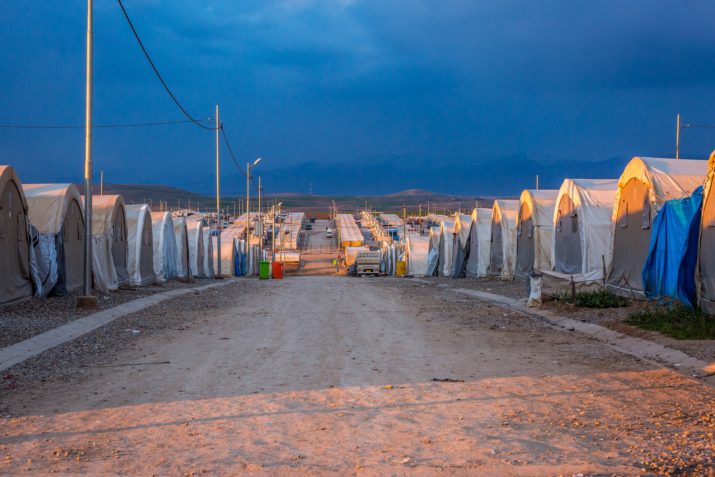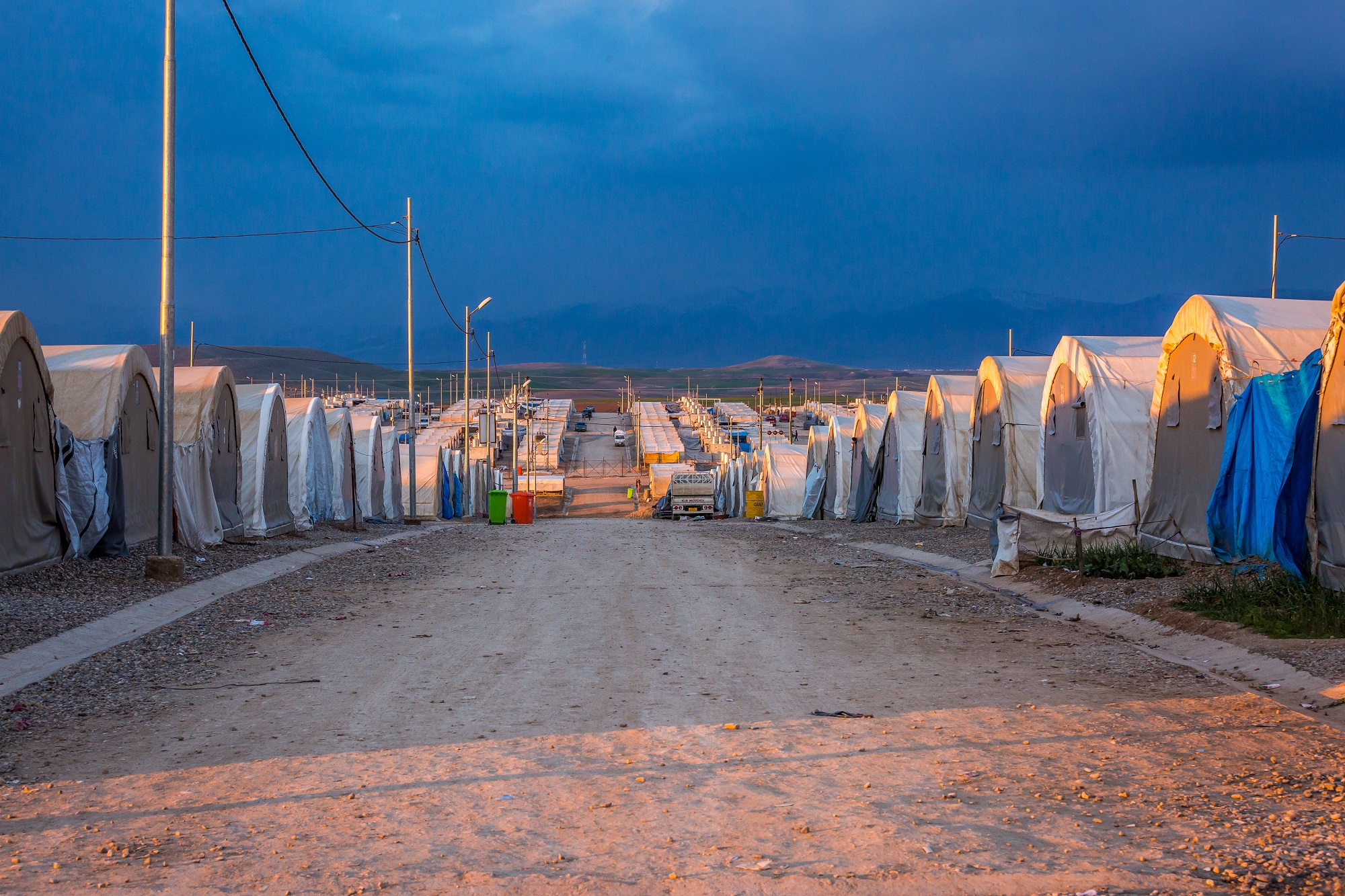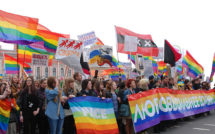

This is part of our special feature The Gender of Power.
A “refugee crisis” has been at the center of European politics as millions of asylum-seekers have crossed the Mediterranean Sea to seek safety in Europe. European states have frantically constructed border walls, reinstated identification checks at previously unregulated borders, and reformed immigration policies to curtail the number of asylum-seekers their countries take in, as well as to discourage those yet to make the journey (UNHCR 2015a). Together, with right-wing nationalists, the European news media has constructed the “myth of the immigrant rapist” during the refugee influx to defend policies that closed borders and cut off services to asylum-seekers.
In the “myth of the immigrant rapist,” white women’s bodies are seen as in need of protection by a paternalist state from the sexual violence of brown men. In the case of Europe’s refugee crisis, this protection took the form of closing borders and harshening immigration policies, including curtailing family reunification for refugees. Thus, to protect native-born white women, asylum-seeking women from the Middle East and Africa are prevented from joining their male family members or safely navigating once-open borders. Many are trapped in a precarious limbo in refugee camps in Lebanon, Turkey, and Greece. In these insecure spaces, asylum-seeking women are often subjected to sexual violence (Lee 2016; Petkova 2017). Thus, the debate is not about a feminist concern with sexual violence but rather nationalist concerns with protecting seemingly insecure borders.
Following the work of Angela Davis (1981) and her “myth of the Black rapist,” we find that European news media and right-wing nationalists conjure up the immigrant rapist to further marginalize these communities, and attempt to limit their access by calling for closed borders, especially to refugees. Myths are “depoliticized speech” that function to “foreclos[e] discussion of politics as they use fantastic characters and situations that depict hierarchal relationships broadly believed to have bearing on ‘real life’ without having to explain these relationships” (Barthe 1972, as quoted in Wright 2006). The myth of the immigrant rapist fails to acknowledge the history of immigration to Europe, and reduces immigrants from a wide range of cultural, economic, and religious backgrounds to a singular entity: the violent, misogynist brown man.[1] The myth is perpetuated through news media and political speech, especially through focused media attention on accounts of crimes committed by immigrant men and silence surrounding crimes committed by white men. In this way, the myth creates the specter of the immigrant rapist without needing to provide broader context of the problem of sexual violence, simply reducing sexual violence to a problem of “culture” or “religion.”[2]
In 2015 alone, over a million refugees traveled to Europe from the Middle East via the Mediterranean (UNHCR 2015b). The number has since declined, though hundreds of thousands are still coming every year, with thousands perishing along the way.[3] Germany and Sweden took in a significant percentage of these northern European-bound refugees, though a large number have registered for asylum in Norway, Denmark, and Finland as well (DeSilver 2015). With the influx of asylum-seekers, there has been conflict over perceived cultural differences, especially in the case of sexual norms and behavior of refugee men. Right-wing political parties and citizens have been calling for increased restrictions on immigration and asylum. In much of their rhetoric, they focus not only on refugees taxing resources, overcrowding cities, harboring terrorists, and disrupting homogeneity of culture, but also on their violent sexual natures compromising the safety of white, Western women in nations that have for the past century been some of the most progressive on women’s rights.
Of these million refugees that traveled by sea to Europe in 2015, a significant portion were young men (UNHCR 2015b). Several reasons explain this skew: young men are most at risk for violence, including being forced to join in the conflict. Another reason is because of the high price, both monetarily as well as the risk, of traveling to Europe without documentation in an attempt to gain asylum. Thus, many men with families traveled alone and hoped that once they were officially approved for asylum, they could then apply for family reunification to buy plane tickets for their families, a much cheaper and safer option than paying human smugglers the high prices for a dangerous journey (Lee 2016). According to Swedish government statistics, the country with the most transparent records on asylum applications, 71 percent of applicants for asylum in 2015 were male (Swedish Migration Agency 2016). In the EU as a whole, the distribution of asylum applicants does show in 2015 men did seek asylum in higher rates than women, most pronounced in the 14-17 and 18-34 years old demographics, where around 80 percent were male (Eurostat 2016).
Hudson (2016) argues the refugee crisis will be the source of a potential “man problem” in Sweden, when a skewed sex ratio of young people in the Swedish population will lead to increased violence against women. She claims it will be a “tragedy for European men and women alike,” considering how far these countries have come in terms of gender equality. She argues in her vastly circulated article that Europe’s man problem stems from the fact that so many migrants traveling to Europe from the Middle East are men and boys, and as a result, the sex ratios of the European countries will be skewed in such a way that will be dangerous for European women, since “rape and sexual harassment become more common in highly masculinized societies, and women’s ability to move about freely and without fear within society is curtailed” (Hudson 2016). Although she does not explicitly call for the restricting of the asylum process as a result of the imbalanced sex ratio, the fear rhetoric remains the same: Europe should be wary for young, brown men are a danger to the women for whom the progressive state has worked so hard for equality.
This argument is not only harmful to these men who are depicted as sexually violent and always a potential danger, it also invisibilizes the women and girls who made the decision to not make the dangerous journey led by human smugglers, with the plans to join their male relatives using the European countries’ family reunification process for refugees. Rather than a solution requiring closing borders to Muslim men, facilitating safer passage and more humane conditions to all asylum-seekers could balance the sex ratios and have more women be able to seek safety from war and violence as well.
In looking at Germany and Scandinavia during the 2015 refugee influx and beyond, we see the way that anti-immigrant sentiment was stirred up by the perceptions of sexual violence risk to white, European women. Right-wing parties and citizens tend to ignore or downplay the violence that is perpetrated by white men, and exaggerate sexual assaults perpetrated by foreign men. Even though white European men also commit sexual violence against women, these assaults “often receive international attention only when they corroborate an existing xenophobic narrative targeting a minority group long deemed threatening to both women and the national demographic future” (Kahn 2016). This international attention, in turn, exacerbates the misperception of the threat and justifies the harshening of immigration policies and the stricter policing of borders to keep these “dangerous” men out.
Until 2016, by German law, rape could not be prosecuted without the presence of force; thus, in many cases, women who were intoxicated or unable to consent, but also unable to physically protest were not protected by the law. Because of the Cologne sexual assault incident, the German law was reexamined with a renewed urgency, so that victims of sexual assault do not have to prove force to hold their attacker accountable (Kirchner and Noack 2016). In short, it took an incident of multiple sexual assaults, by foreign men, to provide the impetus for changing the law. Although the revision of this law could be a positive change for the German system, it is telling that the urgency with which it was passed was prompted by the xenophobic backgrounding of an attack against white women by brown men.
Women’s bodies as border control
It is not a new phenomenon that protection of women’s bodies is used as the justification for violence against men from “other” groups (Ticktin 2008; Razack 2004). Europe’s right-wing media and politicians have taken advantage of a few high-profile sexual violence crimes to construct the myth of the immigrant rapist. In doing so, they call for the closing of the borders as a way to protect white, European women against the dangerous, brown men who are coming to Europe seeking asylum. There was a resurgence of this rhetoric in Germany after the New Years’ Eve attack in 2016, and these “national interpretations… drew on longstanding ideas that use images of women’s vulnerable bodies to express fears of vulnerable national borders” (Kahn 2016). Much of the perpetuation of the immigrant rapist myth in Europe is a result of both the media and political attention to sexual assaults by foreign men. According to Walby et al. (1983) “[n]ewspaper reports of rape are an important medium in which the dominant discourse on rape is articulated” (86). If the European mainstream media reports more frequently on rape cases where the perpetrator is an immigrant while the victim is native-born, a racialized cultural discourse is cultivated.
When white men commit sexual assault or rape, their inclusion into society—indeed, their safety from living in a warzone—is not affected, while immigrant men’s is simply by the perception they might be sexually violent. White men in Europe do not have the same stigma attached to them every time someone from their ethnic group or religion commits a crime. Instead, the myth of the immigrant rapist, like that of the black rapist, serves to “carry out the insidious work of racist ideology” (Davis 580). In the past two years in northern Europe, family reunification policies have become stricter, even in Sweden, where “family-first” policies and rhetoric predominated prior to 2015 (Bech, Borevi, and Mouritsen 2017). Because of these decisions, the process of seeking asylum has been made more difficult.
In northern Europe, with the exaggeration of rape perpetrated against white women, the fact that asylum-seeking women are more vulnerable to sexual assault is often ignored. In the beginning of the 2015 refugee influx, asylum-seekers were predominantly young men; however, by March of 2016 after the change in immigration policy, 62 percent of refugees arriving from the Aegean Sea were women and children, according to the U.N. High Commissioner for Refugees (Lee 2016). Gemma Gillie, British spokeswoman for Medecins San Frontieres (Doctors Without Borders) remarked, “the demographic has completely flipped since last summer. Last year it was the strongest young men who were sent first, because it was a journey into the unknown. Now it is the women and children who are following” (Faiola and Booth 2016). Families that had made plans in 2015 to send over a male relative earlier then bring over the rest of the family “legally have been frozen in bureaucracy and stiffening laws requiring migrants to wait longer before close family members can join them” (Faiola and Booth 2016).
Although women are crossing the same dangerous waters as the men, they are vulnerable to additional dangers because of the highly-masculinized spaces of the migration route. Policies that curtail family reunification and limit asylum numbers force migrant women into dangerous situations where they are more at risk for sexual violence, including assault and coercive sex by human smugglers as payment for passage (Petkova 2016). With the closing of borders and extended family reunification guidelines, many women and their children have been trapped in Turkey and Greece, unable to join their male family members who may have gone ahead the year before (Lee 2016). In their attempts to protect “their” women and their borders, European politicians have forced other women into increasingly dangerous situations.
Sexual assault is racialized, and the myth of the immigrant rapist uses women’s bodies to police borders in Europe (Ticktin 2008). Until the myth of the immigrant rapist is recognized and dismantled in the popular imagination, feminist concerns with violence against women will be used as justification for racism and xenophobia. With the frightening increase in visibility of white nationalism in Europe, feminist scholars must dismantle this rhetoric. Women should be given full autonomy and ownership of their bodies, rather than the paternalist state needing to protect them from a threat that has little basis.
Sexual violence is a real problem, even in the most gender-progressive countries in the world, but turning away asylum-seekers will not curb the violence. Rather, it privileges the bodily autonomy of certain women at the expense of others. By restricting immigration policies for the sake of protecting white, native-born women from the threat of sexual assault, Western European states have forced asylum-seeking women into increasingly precarious circumstances where their bodies are more amenable to sexual violence. This hierarchy of worthy bodies reflects the long-standing historical processes that create a “ritualized fear of sexual contamination” as a result of sexual violence from a racialized Other (Bumiller 2008, 137). In the case of the European refugee crisis, the state seeks to protect its borders by using the threat of sexual violence from immigrant men to its native-born women. In so doing, it fails to recognize how the bodies of certain women are privileged at the expense of others. The repercussions to asylum-seeking families, particularly women, are dire. Those fleeing war and political violence are trapped in a legal limbo as they wait longer and longer periods for family reunification and find themselves unable to breech borders that were a few years ago open and unattended. It is vital that the myth of the immigrant rapist is critically examined and debunked, not only because of its influence on immigration policy, but also because it hides the real problem of sexual violence that occurs in families and among acquaintances, a problem that is rarely sensational enough to attract the media and make headlines but affects far more women.
Caitlin Carroll is a graduate student in the Department of Sociology at the University of Texas at Austin. Her dissertation focuses on rape and sexual assault policy and the criminal justice system in Sweden.
Photo: Street of the Kabertoo refugee camp in Iraq, Kurdistan, Matus Duda | Shutterstock
References:
[1] See Abu-Lughod (2013) for a discussion of the flattening of Muslim women’s lives and experiences as well.
[2] See Razack (2004) for a discussion of Canadian rhetoric of culture-based “honor killings” as opposed to domestic violence murders.
[3] In fact, more refugees died at sea in 2016 than 2015, though there was far less media coverage. See Safdar and Strickland (2016).
Abu-Lughod, Lila. 2013. Do Muslim Women Need Saving? Cambridge, MA: Harvard University Press.
Bech, Emily Cochran, Karin Borevi, and Per Mouritsen. A ‘civic turn’ in Scandinavian family migration policies? Comparing Denmark, Norway and Sweden. Comparative Migration Studies 5:1, 1-24.
Bumiller, Kristin. 2008. In an Abusive State: How Neoliberalism Appropriated the Feminist Movement against Sexual Violence. Durham, NC: Duke University Press.
Davis, Angela. 1981. Women, Race and Class. New York: Vintage Books Random House Press.
DeSilver, Drew. 2015. Europe’s asylum seekers: Who they are, where they’re going, and their chances of staying. Pew Research Center. http://www.pewresearch.org/fact-tank/2015/09/30/europes-asylum-seekers-who-they-are-where-theyre-going-and-their-chances-of-staying/.
Eurostat. 2016. Asylum statistics. http://ec.europa.eu/eurostat/statistics-explained/ index.php/Asylum_statistics.
Faiola, Anthony and William Booth. 2016. How Europe’s migrant policy is tearing families apart. The Washington Post 13 April 2016. https://www.washingtonpost.com/world/europe/how-europes-migrant-policy-is-tearing-families-apart/2016/04/12/c4d8bdf8-fb41-11e5-813a-90ab563f0dde_story.html?utm_term=.f22cf42d55e8.
Higgins, Andrew. 2015. Norway offers migrants a lesson in how to treat women. The New York Times 19 December 2015. http://www.nytimes.com/2015/12/20/world/europe/norway-offers-migrants-a-lesson-in-how-to-treat-women.html
Hudson, Valerie. 2016. Europe’s man problem. Foreign Policy 11 January 2016. http://www.politico.eu/article/europes-man-problem/.
Kahn, Michelle. 2016. The Cologne sexual assaults in historical perspective. Notches 19 January 2016. http://notchesblog.com/2016/01/19/the-cologne-sexual-assaults-in-historical-perspective/
Karnitschnig, Matthew, Anton Troianovski and Jenny Gross. 2015. Europe’s anti-immigrant parties stand to gain ground in wake of Paris attacks. The Wall Street Journal 16 January 2015. http://www.wsj.com/articles/europes-anti-immigrant-parties-stand-to-gain-ground-in-wake-of-paris-attacks-1421371307.
Kirchner, Stephanie and Rick Noack. 2016. New, stricter sexual-assault laws in Germany are making refugee activists uneasy. The Washington Post 7 July 2016. https://www.washingtonpost.com/news/worldviews/wp/2016/07/07/why-stricter-sexual-assault-laws-in-germany-make-refugee-activists-uneasy/?utm_term=.3d4cb99af018.
Lee, Esther Yu-His. 2016. Women and kids now driving migration wave into Europe. Think Progress 7 March 2016. http://thinkprogress.org/immigration/2016/03/07/3757219/female-refugees-europe/.
Petkova, Mariya. 2016. Violence and abuse against asylum seekers and refugees in Europe. Al-Sharq Forum June 2016. http://sharqforum.org/2016/07/01/violence-and-abuse-against-asylum-seekers-and-refugees-in-europe/.
Razack, Sherene. 2004. Imperiled Muslim women, dangerous Muslim men and civilised Europeans: Legal and social responses to forced marriages. Feminist Legal Studies 12, 129-174.
Safdar, Anealla and Patrick Strickland. 2016. 2016: The year the world stopped caring about refugees. Al Jazeera. http://www.aljazeera.com/indepth/features/2016/12/2016-year-world-stopped-caring-refugees-161227090243522.html.
Swedish Migration Agency. 2016. http://www.migrationsverket.se/Om-Migrationsverket/Statistik/Aktuell-statistik.html.
Ticktin, Miriam. 2008. Sexual violence as the language of border control: Where French feminist and anti-immigrant rhetoric meet. Signs 33:4, 863-889.
United Nations High Commissioner on Refugees (UNHCR). 2015a. Global trends: Forced displacement in 2015. http://www.unhcr.org/576408cd7.pdf.
United Nations High Commissioner on Refugees (UNHCR). 2015b. Over one million sea arrivals reach Europe in 2015. 30 December 2015. http://www.unhcr.org/5683d0b56.html.
Walby, Sylvia, Alex Hay, and Keith Soothill. 1983. The social construction of rape. Theory, Culture, and Society 2:1, 86-98.
Wright, Melissa. 2006. Disposable Women and Other Myths of Global Capitalism. Routledge.
Published on July 6, 2017.




